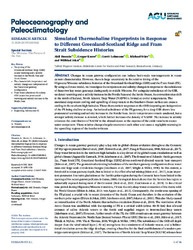Simulated Thermohaline Fingerprints in Response to Different Greenland-Scotland Ridge and Fram Strait Subsidence Histories
DOI: https://doi.org/10.1029/2019PA003842
Persistent URL: http://resolver.sub.uni-goettingen.de/purl?gldocs-11858/8935
Persistent URL: http://resolver.sub.uni-goettingen.de/purl?gldocs-11858/8935
Hossain, Akil; Knorr, Gregor; Lohmann, Gerrit; Stärz, Michael; Jokat, Wilfried, 2020: Simulated Thermohaline Fingerprints in Response to Different Greenland-Scotland Ridge and Fram Strait Subsidence Histories. In: Paleoceanography and Paleoclimatology, Band 35, 7, DOI: 10.1029/2019PA003842.
 |
Dokument öffnen: |
Changes in ocean gateway configuration can induce basin-scale rearrangements in ocean current characteristics. However, there is large uncertainty in the relative timing of the Oligocene/Miocene subsidence histories of the Greenland-Scotland Ridge (GSR) and the Fram Strait (FS). By using a climate model, we investigate the temperature and salinity changes in response to the subsidence of these two key ocean gateways during early to middle Miocene. For a singular subsidence of the GSR, we detect warming and a salinity increase in the Nordic Seas and the Arctic Ocean. As convection sites shift to the north of Iceland, North Atlantic Deep Water (NADW) is formed at cooler temperatures. The associated deep ocean cooling and upwelling of deep waters to the Southern Ocean surface can cause a cooling in the southern high latitudes. These characteristic responses to the GSR deepening are independent of the FS being shallow or deep. An isolated subsidence of the FS gateway for a deep GSR shows less pronounced warming and salinity increase in the Nordic Seas. Arctic temperatures remain unaltered, but a stronger salinity increase is detected, which further increases the density of NADW. The increase in salinity enhances the contribution of NADW to the abyssal ocean at the expense of the colder southern source water component. These relative changes largely counteract each other and cause a negligible warming in the upwelling regions of the Southern Ocean.
Statistik:
ZugriffsstatistikSammlung:
- Geographie, Hydrologie [454]
Schlagworte:
Gateway subsidenceMiocene
Fingerprints
Greenland-Scotland Ridge
Fram Strait
Temperature and salinity change
This is an open access article under the terms of the Creative Commons Attribution License, which permits use, distribution and reproduction in any medium, provided the original work is properly cited.

